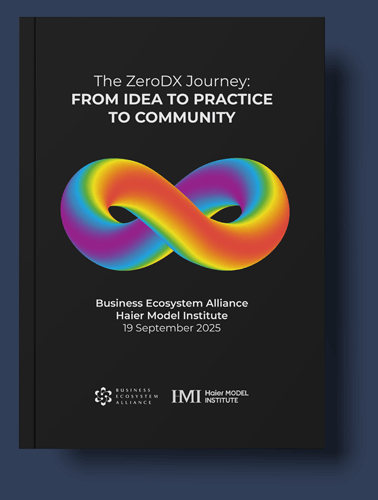Will Individual Companies Exist 50 Years from Now?
Or will business ecosystems eliminate the need for firms as we know them?
The Theory of the Firm
Why do companies exist? British economist Ronald Coase’s 1937 Theory of the Firm tells us that the existence of a firm is necessary when the costs of managing coordination internally are less than the transaction costs in the external marketplace.
Historically, for complex practices like hiring and managing employees, governing relationships with suppliers and partners, and controlling routine processes, this made sense. Vertically integrated corporations with structures and processes could do a much better job of coordinating a system of complex moving parts than the external market could.
However, advanced digital technologies have significantly reduced external transaction costs and removed many of the frictions in external marketplaces. In a world of dynamically adaptive digital ecosystems, will we still need companies to provide internal coordination?
Competition in the age of ecosystems
Outthinker recently teamed up with Thinkers50, the Business Ecosystem Alliance, and Haier to explore the rise of business ecosystems—how they are changing and how they are impacting competition and the way we work together. Thought leaders including Felix Oberholzer-Gee, James Moore, Jonathan Knee, Rita McGrath, Ron Adner, and more offered their insights through in-depth interviews based on years of study and practice. In an interview with Martin Reeves, chairman of the BCG Henderson Institute, we tested the Theory of the Firm against the evolution of ecosystems.
James was the first to describe the idea of competition among business ecosystems when his 1993 article, “Predators and Prey: A New Ecology of Competition,” compared ecosystems in biology to ecosystems in business. He introduced the observation that companies do not operate in a vacuum, but rather they are part of a complex collaborative and competitive environment called an ecosystem.
Business ecosystems themselves are not new. Even as early as 4th to 1st century B.C., historians have records of cooperatives of blacksmiths working with the Roman Republic to produce tools and weaponry. In 1000 A.D. monasteries became procurers, learning centers, and motivators for the artistry of traveling blacksmiths. This is just one of many examples of coalitions that united to connect producers to partners and to upskill workers. It seems that as long as merchants have worked to satisfy customer needs, there have been ecosystems formed to get the job done.
The evolution of ecosystems
Since ecosystems have been around for so long, I wondered if they are really increasing in importance as much as we propose. Martin’s research found that the term “business ecosystem” is used today 13 times more than it was 10 years ago. In 1990, only one of the world’s 10 largest companies could be considered an ecosystem. Today, seven of the 10 fit the description. Evidence points to the fact that we are currently living in a world of rapidly expanding ecosystems.
While ecosystems have existed throughout history, the most transformational changes have occurred since digital technologies entered the mix. The digital revolution starting in 1989 brought the arrival of cheap computing power, high bandwidth communication, artificial intelligence (AI), and agile software processes. Since then, the effort and transactional cost of coordinating the external marketplace have come down significantly.
Successful digital ecosystems target value creation in areas where traditional companies leave friction. Consider ecosystems in staffing. Traditionally, the hiring process through an internal company application portal and interview process have been found to be expensive, slow, and inaccurate. With digital platforms, candidates find jobs and communicate with companies through multiple channels, often externally.
There’s also US healthcare, where systemic frictions have left many uninsured, and the federal or state government has run a marketplace since 2010. Across industries, the ability for the market to remove friction and coordinate transactions outside of single companies via digital platforms continues to improve.
The future of the firm
As digitization increases and the coordination of complexity in the external marketplace becomes easier, what will the firm become? Will we still see individual companies 50 years from now? Martin assures us that we will.
As more firms join ecosystems, the idea of a company will morph and boundaries between companies will continue to blur, often across industry and competitive lines. In fact, the future may bring even more companies, Mark Zuckerburg stated in a recent interview, as the metaverse evolves and individuals set up shops and platforms in new virtual worlds.
Martin reminds us that ecosystem strategy is only one of the strategic choices available to organizations today. His idea of “contingent strategy” dictates that businesses must choose the right strategic approach for the situation and challenges. An ecosystem strategy is not necessarily the answer for all companies all the time.
The thing that may cease to exist as we know it is management inside of companies. Managers are trained to impose structure and restriction. Such traditional management can get in the way of the natural flexibility and coordination of what Martin calls “self-tuning” ecosystems.
In the future, he predicts that managers will be much more hands-off, managing the human skills that algorithms cannot substitute: counterfactual thinking, empathy, and ethics.
Conclusion
The growth of business ecosystems will not cause the disappearance of the firm. Rather, as the external marketplace proves itself a better mechanism for certain types of transaction, the firm will retreat from some activities, change its focus to helping to coordinate new things, and come to look more like an ecosystem itself.
The nature of a firm will evolve. This will require a different mindset, one that is dynamic instead of in pursuit of five- or 10-year plans. The nature of leadership will change as well, with values geared toward external collaboration, side-by-side rather than top-down management, and a focus on creativity and continuous learning to participate in an evolving, adaptive environment.
To find out more about the future of ecosystems, check out the full interview with Martin Reeves and the complete set of thought leader interviews from the “Competition in the Age of Ecosystems” event.
Bios
Kaihan Krippendorff began his career with McKinsey & Company before founding growth strategy and innovation consulting firm Outthinker. Recognized by Thinkers50 as one of the top 8 innovation thought leaders in the world, he is the author of five best-sellers, most recently the Edison Award nominated, Driving Innovation from Within: A Guide for Internal Entrepreneurs. Amidst a dizzying schedule of keynote speeches, consulting projects, and ongoing research, Kaihan finds time to teach at business schools globally (including NYU and FIU), write regularly for Fast Company and other major media outlets, and play an active role on four corporate advisory boards.
Cori Dombroski directs marketing for Outthinker and manages the member experience for the Outthinker Strategy Network. Her professional background includes leading Channel Enablement and Partner Marketing for IBM Data & Analytics segments and producing content for the Growth Institute’s Scaling Up courses. She has also been a teacher of language and literature who continues to be passionate about education, storytelling, and connecting communities of inspired individuals.


